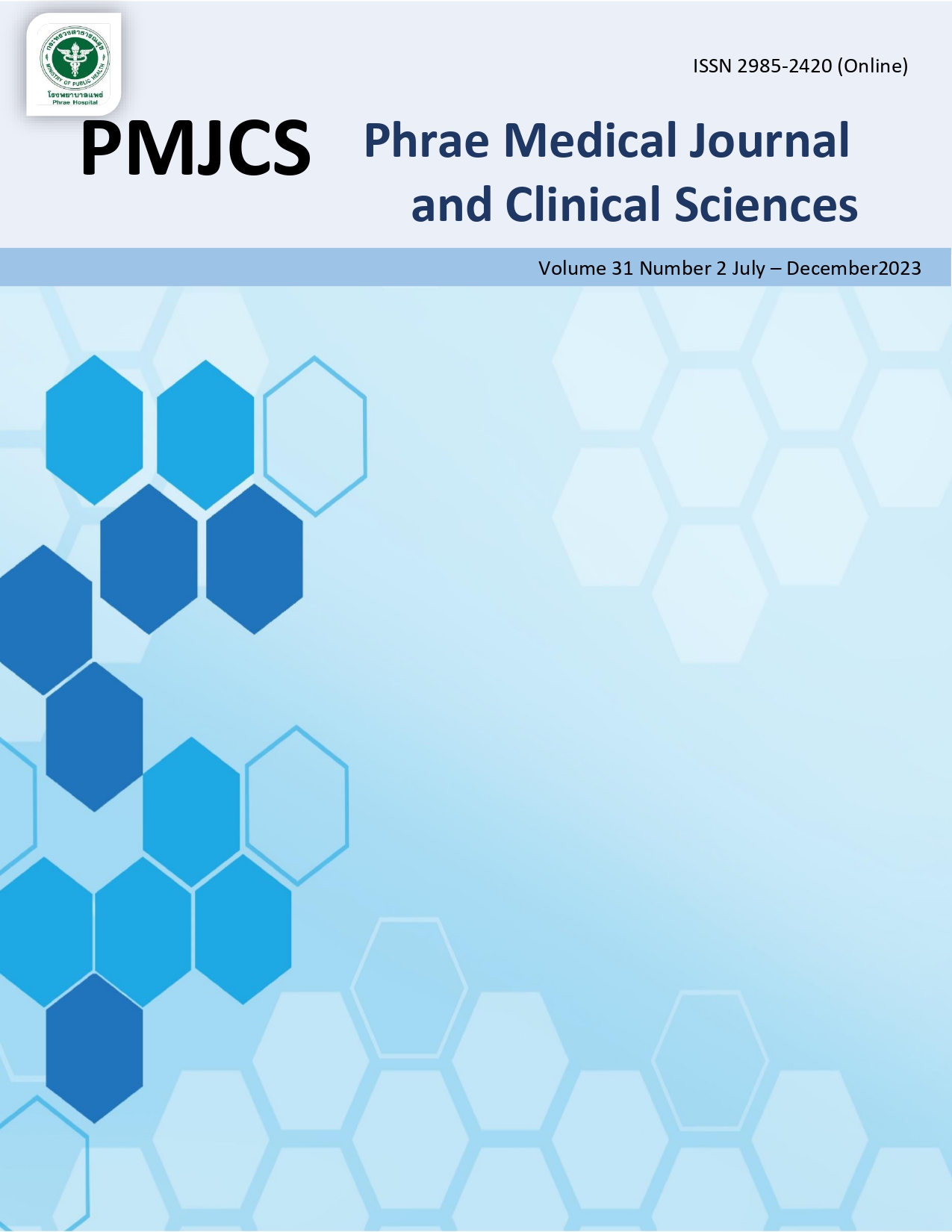Effects of developing a surveillance and monitoring model for pregnant women at risk of preterm birth using a line application
Abstract
Background: Preterm birth is a major public health problem and requires a system of close monitoring and monitoring. To reduce the problem of preterm birth.
Objective: To develop the model and effectiveness of surveillance and monitoring of pregnant women at risk of preterm birth using LINE application.
Study design: It is research and development. The sample consisted of 24 registered nurses in the Obstetric-Gynecological Outpatient Nursing Group, Obstetrics-Gynecology Building and Delivery Room Department at Lamphun Hospital, and pregnant women who received services at the antenatal clinic. Lamphun Hospital: 30 people. The tools used to conduct the research include counseling to monitor and monitor pregnant women at risk of preterm birth using a LINE application. Data collection tools include questionnaires for pregnant women, questionnaires for registered nurses and preterm birth incidence records. Analyze data with descriptive statistics, including frequency, percentage, mean, standard deviation, and inferential statistics including Paired t-test with a statistical significance level of 0.05.
Results: Consultation model to monitor and monitor pregnant women at risk of preterm birth using LINE application "Clinic Preterm" account is a form of education and consultation with infographics and online videos on risks, effects, risk factors and prevention of preterm birth. In terms of the effectiveness of the model, it was found that after the use of the model, pregnant women had knowledge of the risk of preterm birth and were able to better behave in preventing preterm birth statistical significance (p<0.05). And the majority 93.3% gave birth as scheduled. In terms of satisfaction with the model found that the sample of pregnant women and registered nurses had the highest satisfaction with the format (mean= 4.40 and 4.21)
Conclusions: This model helps to increase knowledge and results in pregnant women are aware of the importance of their practices in preventing preterm birth.
Keywords: Surveillance and Monitoring, Pregnant Women, Preterm Birth Risk, Line Application
References
WHO. Preterm birth [Internet]. 2018 [cited 2022 December]; Available from https://www.who.int/news-room/fact-sheets/detail/preterm-birth
Cunningham F, Leveno K, Bloom S, Dashe J, Hoffman B & Casey B. Preterm birth. New York: McGraw-Hill Education; 2018.
ธราธิป โคละทัต. ผลกระทบของคลอดก่อนกำหนด. กรุงเทพฯ: อมรินทรพริ้นติ้งแอนด์พับลิชซิ่ง; 2561.
Hack M, Klein NK, Taylor HG. Longterm developmental outcomes of low birth weight infants. The Future of Childdren 2015;5(1):176-96.
ถวัลยว์งค์ รัตนสิริ, ฐิติมา สุนทรสัจ, สมศักดิ์ สุทัศน์วรวุฒิ. สูติศาสตร์ฉุกเฉิน. สมุทรสาคร: พิมพ์ดี; 2554.
เพียงขวัญ ภูทอง. การดูแลแบบต่อเนื่องเพื่อป้องกันการคลอดก่อนกำหนด. วารสารเกื้อการุณย์2562;10(2):156-68.
รุ้งตวรรณ์ ช้อยจอหอ, เยาวลักษณ์ เสรีเสถียร, เอมพร รตินธร, เอกชัย โควาวิสารัช. ผลของการบำบัดทางการพยาบาลต่อการจัดการเพื่อป้องกันภาวะเจ็บครรภ์คลอดก่อนกำหนด การกลับมารักษาซ้ำและอายุครรภ์เมื่อคลอดในหญิงตั้งครรภ์ที่มีภาวะเจ็บครรภ์คลอดก่อนกำหนด. วารสารพยาบาลศาสตร์ 2562;7(2): 39-48.
Goldenberg RL. The management of preterm labor. Obstetric & Gynecology 2012;23(100):1020-37.
โรงพยาบาลลำพูน. รายงานความเสี่ยงทางสูติ-นรีเวชกรรม โรงพยาบาลลำพูน. ลำพูน: โรงพยาบาลลำพูน; 2565.
วนิสา หะยีเซะ, นุจรี ไชยมงคล, อัจฉราวดี ศรียะศักดิ์, มยุรี ยีปาโล๊ะ. การพัฒนาแอปพลิเคชั่นบนแอนดรอยด์: ผลของการให้ความรู้แอปพลิเคชั่นในการดูแลทารกเกิดก่อนกำหนดหลังจำหน่ายออกจากโรงพยาบาลตามวิถีมุสลิม. วารสารมหาวิทยาลัยนราธิวาสราชนครินทร์ 2564;13(1):39-55.
กิติยาพร สังฆศรีสมบัติ, ชรินทร์พร มะชะรา, มนัสนันท์ พรมศรี, นิรันดร ผานิจ. การพัฒนารูปแบบการให้ความรู้และให้คำปรึกษาผ่านแอปพลิเคชัน ไลน์ออฟฟิเชียลแอ็กเคานต์ สำหรับมารดาในการดูแลทารกเกิดก่อนกำหนด. วารสารศูนย์อนามัยที่ 9 2565;16(2): 623.-41.




